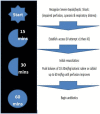Poor Compliance with Sepsis Guidelines in a Tertiary Care Children's Hospital Emergency Room
- PMID: 29675402
- PMCID: PMC5895651
- DOI: 10.3389/fped.2018.00053
Poor Compliance with Sepsis Guidelines in a Tertiary Care Children's Hospital Emergency Room
Abstract
Objectives: This study aimed to assess factors related to adherence to the Pediatric Advanced Life Support guidelines for severe sepsis and septic shock in an emergency room (ER) of a tertiary care children's hospital.
Methods: This was a retrospective, observational study of children (0-18 years old) in The Children's Hospital of San Antonio ER over 1 year with the International Consensus Definition Codes, version-9 (ICD-9) diagnostic codes for "severe sepsis" and "shocks." Patients in the adherent group were those who met all three elements of adherence: (1) rapid vascular access with at most one IV attempt before seeking alternate access (unless already in place), (2) fluids administered within 15 min from sepsis recognition, and (3) antibiotic administration started within 1 h of sepsis recognition. Comparisons between groups with and without sepsis guideline adherence were performed using Student's t-test (the measurements expressed as median values). The proportions were compared using chi-square test. p-Value ≤0.05 was considered significant.
Results: A total of 43 patients who visited the ER from July 2014 to July 2015 had clinically proven severe sepsis or SS ICD-9 codes. The median age was 5 years. The median triage time, times from triage to vascular access, fluid administration and antibiotic administration were 26, 48.5, 76, and 135 min, respectively. Adherence to vascular access, fluid, and antibiotic administration guidelines was 21, 26, and 34%, respectively. Appropriate fluid bolus (20 ml/kg over 15-20 min) was only seen in 6% of patients in the non-adherent group versus 38% in the adherent group (p = 0.01). All of the patients in the non-adherent group used an infusion pump for fluid resuscitation. Hypotension and ≥3 organ dysfunction were more commonly observed in patients in adherent group as compared to patients in non-adherent group (38 vs. 14% p = 0.24; 63 vs. 23% p = 0.03).
Conclusion: Overall adherence to sepsis guidelines was low. The factors associated with non-adherence to sepsis guidelines were >1 attempt at vascular access, delay in antibiotic ordering, fluid administration using infusion pump, absence of hypotension, and absence of three or more organs in dysfunction at ER presentation.
Keywords: adherence; guidelines; management; septic shock; severe sepsis.
Figures



Similar articles
-
Surviving sepsis campaign: international guidelines for management of severe sepsis and septic shock: 2012.Crit Care Med. 2013 Feb;41(2):580-637. doi: 10.1097/CCM.0b013e31827e83af. Crit Care Med. 2013. PMID: 23353941
-
Sepsis Care Pathway 2019.Qatar Med J. 2019 Nov 7;2019(2):4. doi: 10.5339/qmj.2019.qccc.4. eCollection 2019. Qatar Med J. 2019. PMID: 31763206 Free PMC article.
-
Adherence to PALS Sepsis Guidelines and Hospital Length of Stay.Pediatrics. 2012 Aug;130(2):e273-80. doi: 10.1542/peds.2012-0094. Epub 2012 Jul 2. Pediatrics. 2012. PMID: 22753559
-
Time- and fluid-sensitive resuscitation for hemodynamic support of children in septic shock: barriers to the implementation of the American College of Critical Care Medicine/Pediatric Advanced Life Support Guidelines in a pediatric intensive care unit in a developing world.Pediatr Emerg Care. 2008 Dec;24(12):810-5. doi: 10.1097/PEC.0b013e31818e9f3a. Pediatr Emerg Care. 2008. PMID: 19050666
-
A quality improvement project to improve early sepsis care in the emergency department.BMJ Qual Saf. 2015 Dec;24(12):787-95. doi: 10.1136/bmjqs-2014-003552. Epub 2015 Aug 6. BMJ Qual Saf. 2015. PMID: 26251506 Review.
Cited by
-
Improving fluid resuscitation in pediatric shock with LifeFlow®: a retrospective case series and review of the literature.Open Access Emerg Med. 2019 Apr 24;11:87-93. doi: 10.2147/OAEM.S188110. eCollection 2019. Open Access Emerg Med. 2019. PMID: 31118839 Free PMC article.
-
Association of Antibiotics Administration Timing With Mortality in Children With Sepsis in a Tertiary Care Hospital of a Developing Country.Front Pediatr. 2020 Sep 9;8:566. doi: 10.3389/fped.2020.00566. eCollection 2020. Front Pediatr. 2020. PMID: 33014945 Free PMC article.
References
LinkOut - more resources
Full Text Sources
Other Literature Sources
Miscellaneous

